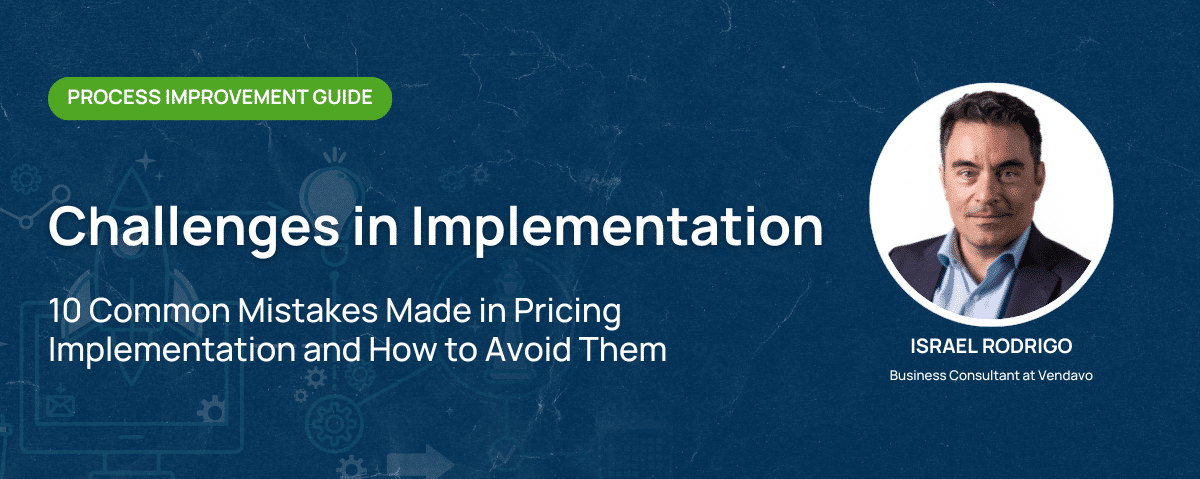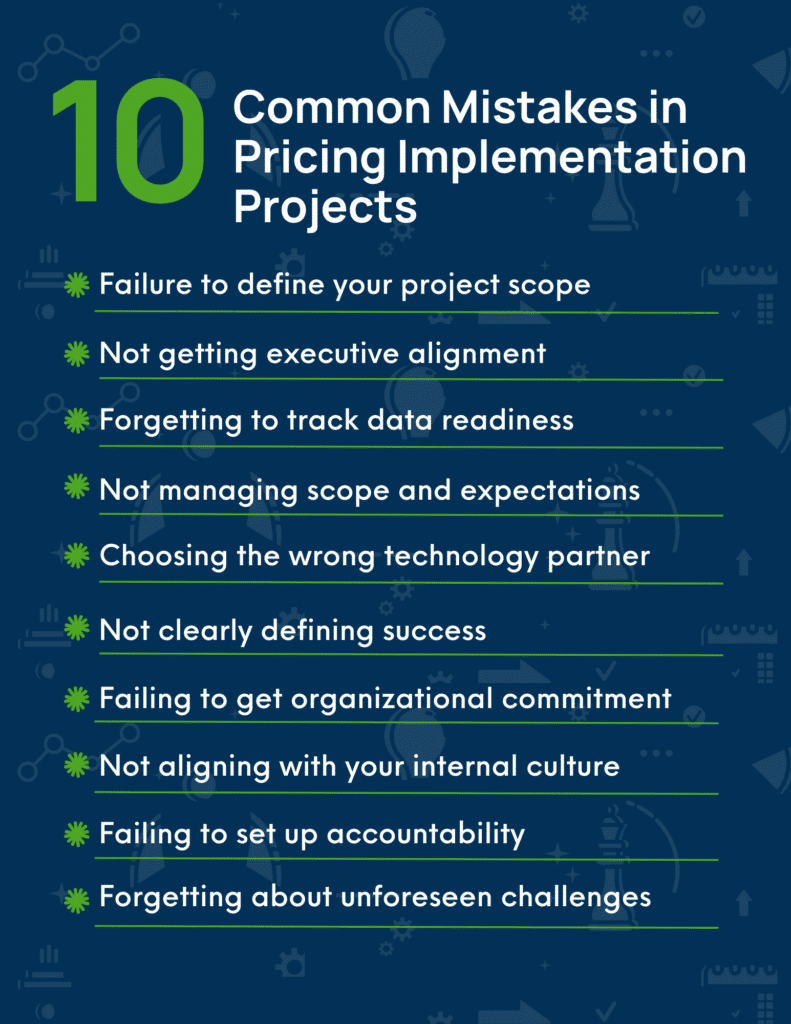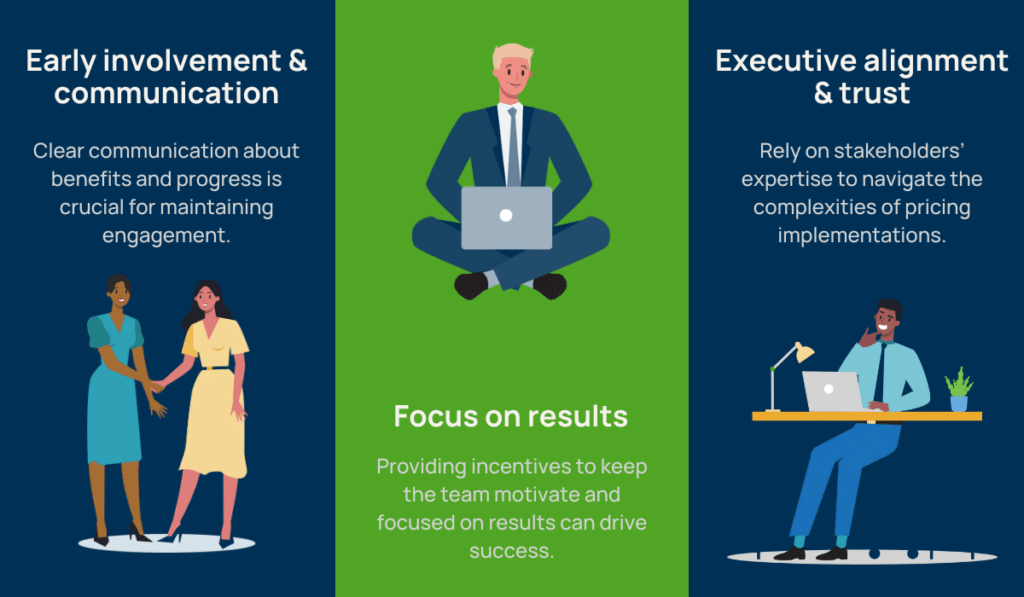
The decision to implement new pricing technology is a big deal, but the process becomes manageable with the right approach. Israel Rodrigo, Business Consultant at Vendavo, breaks down the common challenges involved in implementations and shares his insights on how to navigate them effectively.
Implementing new pricing technology can feel like trying to navigate a maze without a map. The process is full of potential pitfalls and challenges that can leave even the most seasoned professionals scratching their heads.
If this describes you, you’re not alone. Whether you’re dealing with data disarray, struggling to get everyone on the same page, or unsure about choosing the right technology partner, this guide is for you.
Here’s what to know about the most common pricing implementation issues (and how to solve them) so you can make your pricing technology implementation project as smooth as possible.

1. Failure to define your project scope
Knowing what you need from your pricing function is essential. Modern pricing technology offers flexibility, allowing you to go beyond merely producing price lists and tariffs.
But without a clear understanding of the benefits and scope of the pricing function, projects can quickly derail. Define the pricing function’s deliverables and benefits to set realistic expectations and avoid scope creep.
2. Not getting executive alignment
Organizations often face resistance at the top levels. Securing executive buy-in early is crucial for a smooth implementation journey.
Ensure everyone understands the goal and is working toward the same outcome. This helps maintain momentum and keeps the project on track, reducing the risk of misalignment and conflicting priorities.
3. Forgetting to track data readiness
Getting your data ready is a fundamental step in implementation. Many organizations struggle with disjointed data environments, which can lead to challenges in accuracy and accessibility.
Organize your data in centralized master data environments to ensure consistency, accuracy, and for more-informed pricing decisions. Address any issues with outdated systems that can cause data disarray.
4. Not managing scope and expectations
Organizations often make the mistake of attempting to tackle everything at once, which can lead to prolonged and expensive projects. Focus on key priorities and pain points first.
A phased approach allows you to build a solid foundation before expanding the project. By addressing the most pressing issues first, you can make incremental improvements and adjustments, ensuring a more manageable and effective implementation process.
5. Choosing the wrong technology partner
The right partner should provide valuable insights, recommendations, and support throughout the process. This long-term commitment requires a vendor who understands the unique needs of the organization and can offer tailored solutions and guidance.
Choose a vendor who offers valuable insights and ongoing support. Ensure they are committed to your long-term success, understand your unique needs, and offer customized solutions that can significantly contribute to the project’s success.
6. Not clearly defining success
A major barrier to success is the lack of a clear definition of what success looks like.
Avoid seeking a one-size-fits-all solution and establish clear, realistic success metrics from the beginning.
7. Failing to get organizational commitment
Implementing pricing technology requires a committed organization. Changes in leadership, lack of motivation among users, and insufficient involvement of key stakeholders can hinder progress.
Ensuring that the right people are motivated and engaged from the beginning is critical.
8. Not aligning with your internal culture
Transformational projects inevitably bring about discomfort and resistance. A culture based on trust, openness, and frequent communication can mitigate these issues.
Foster a culture of frequent communication. This helps in addressing misunderstandings and misalignments early on, ensuring a smoother implementation process.
9. Failing to set up accountability
Hold everyone accountable for their part in the process.
Clear roles and responsibilities help in maintaining focus and drive towards achieving the project’s goals.
10. Forgetting about the unforeseen challenges
Expect the unexpected. Here’s how to deal with common unforeseen challenges:
- Scope misalignment – During evaluation, ensure everyone understands the scope and what will be delivered. Misalignment can lead to confusion and delays, so it’s crucial to align contracts with what was demonstrated and prioritized.
- Resource availability – Involve your best experts to drive the project. Having the necessary resources, both in quantity and quality, is vital for shaping the project’s direction and ensuring its success.
- Clear deliverables – Use methodologies like Agile to keep track of progress. Transparent communication and clear deliverables throughout the project help in addressing issues promptly and maintaining momentum.
Best Practices & Strategies for Pricing Implementation Success
Here are some best practices for a successful implementation:

- Early involvement and communication
Get internal teams involved early in the process to reduce resistance. Clear and consistent communication about the project’s benefits and progress is crucial for maintaining engagement.
- Focus on results
Highlight the tangible benefits of the project, not just the financial ROI. Providing incentives to keep the team motivated and focused on results can drive success.
- Executive alignment and trust
Ensure continuous alignment with executives throughout the project. Rely on the expertise of both internal and external stakeholders to navigate the complexities of pricing technology implementations.
Implementing new pricing technology doesn’t have to be overwhelming.
Focus on executive alignment, clear success definitions, data readiness, and effective communication to set yourself up for success. Remember, it’s not just about the technology. It’s about the people and processes that drive its success.
Ready to take your organization’s growth and profitability to the next level? Reach out today to speak with a Vendavo expert about how our full suite of commercial excellence and revenue optimization solutions can help.
